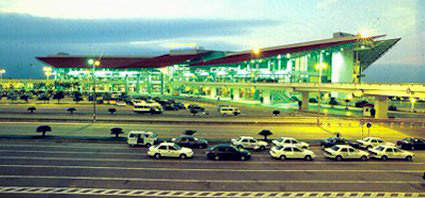Chennai International Airport (previously known as Madras International Airport) is located in Tirusulam, a suburb 7km south of Chennai in the state of Tamil Nadu, India.
It was one of the first airports of India and served Air India flights from Mumbai during the 1950s. The airport is owned by the Government of India and is operated by the Airports Authority of India (AAI).
The airport’s first passenger terminal was built at Meenambakkam town and now acts as a major cargo base. In 1988, a new terminal complex was built at Tirusulam, adjacent to Meenambakkam.
The terminal complex includes an international and a domestic terminal adjacent to each other. The airport has two runways.
The airport served 3,799,211 passengers and handles 46,753 aircraft movements and 224,906 cargo in the period between April 2020 and January 2021.
In 2001, Chennai Airport became the first international airport in the country to receive ISO-9001-2000 certification.
Chennai International Airport expansion timeline
The $2.6bn modernisation and expansion was aimed to increase its capacity to 30 million passengers a year.
The AAI, which is responsible for the integrated development of airports in the country, took up the airport expansion work.
In July 2008, the public investment board (PIB) gave clearance for the development plans at the airport. AAI funded about 80% of the project and 20% came through commercial borrowings.
Work began in October 2008 and construction of the international terminal was completed in July 2011. Expansion work was planned to be completed by the second half of 2011, but it was later postponed to early 2013. The sustainable technology used in the expansion transformed the airport into the greenest airport in India.
Chennai Airport expansion details
The expansion included a new domestic terminal, modernisation of the existing domestic terminal and expansion of the international terminal.
The new domestic terminal and international terminal expansion increased the area to 142,700m² enabling the movement of more than 23 million passengers annually. The terminals are connected by a 1km flyover and features two moving walkways.
After the upgrade, there were four aerobridges for international passengers and six for domestic passengers.
The 15,700m² Anna international terminal can currently handle three million passengers a year. It was expanded by 59,300m² to increase its passenger handling capacity by an additional four million passengers a year.
The upgraded international terminal can handle a capacity of approximately 4,450 passengers during peak hours.
It has eight aerobridges and eight conveyor belts. The 13,000m² Kamaraj domestic terminal can handle six million passengers a year. A new 67,700m² domestic terminal was built with a capacity to handle ten million passengers a year.
The overall domestic terminal capacity is augmented to 16 million passengers a year.
The development also included the construction of a parallel runway interconnected by a taxiway, aprons, two multilevel car parking garages with 1,200 spaces each and improvement of roadway access and infrastructure.
The airport has an integrated cargo complex with ground floor space of 21,000m² and first-floor area of 12,100m². An Rs750m automatic storage and retrieval system was also installed at the complex.
A new 218,000m2 integrated terminal for carrying out international and domestic operations is expected to be commissioned by December 2022. It will improve the annual passenger capacity to 35 million passengers.
Terminal features at Chennai International
The international and domestic terminals are connected by a building containing administrative offices and a restaurant.
The terminals feature basic passenger amenities such as a health scan facility at the domestic terminal, auto vending machines for snacks and magazines, dormitory accommodation and retiring rooms facilities, communication centre for web browsing and video and phone conferencing facilities.
The terminal also offers special assistance including lounges and reserved parking areas for physically handicapped passengers and an infant lobby. The existing international terminal has two aerobridges while the domestic terminal has three.
Check-in, customs and immigration
Upon completion of the expansion, the airport has 140 check-in counters, 60 immigration counters, seven security gates (three international, four domestic), four conveyor belts and seven aerobridges.
The upgraded international terminal has an X-ray baggage handling facility.
Runways at India’s Chennai International Airport
The airport has two runways – 07/25 of 3,658m (asphalt) and 12/30 of 2,045m (asphalt / concrete). The Tamil Nadu State Government has allocated 130 acres of land for the development of a second runway.
The construction of the secondary runway began in May 2009 and was built over the Adyar River by means of a bridge including a taxiway. The project, costing Rs4.3bn, was completed in 2011 but there were many obstructions preventing the extension to meet the specified standards of the International Civil Aviation Organisation.
Road and railway infrastructure
Chennai International Airport is well connected with the state-run bus services and taxis. There is also a special bus service to and from the airport.
The government is also working on the construction of an elevated express highway from Maduravoyal to Chennai Port.
The Chennai Metro rail project connects the airport with various parts of the city.
Contractors
The AAI selected a team of architects for the expansion plan through an international design competition held in June 2007. The team consists of US-based Frederic Schwartz Architects, Hargreaves Associates and Gensler and New Delhi-based Creative Group.
In October 2008, the AAI awarded Rs12.1bn airport expansion contract to a joint venture of Consolidated Construction Consortium (CCCL) and Canadian infrastructure company Herve Pomerleau International.
CCCL’s consortium includes Punj Lloyd, L&T and Nagarjuna Constructions. CCCL is also involved in the construction of a new Rs68bn cargo complex at Chennai Airport.
In October 2009, Areva’s transmission and distribution division (T&D) was awarded a Rs556m power distribution and gas insulated substation system’s supply and installation package. BSCPL Infrastructure was contracted for the bays expansion in the south including three aerobridges for air traffic operations.











